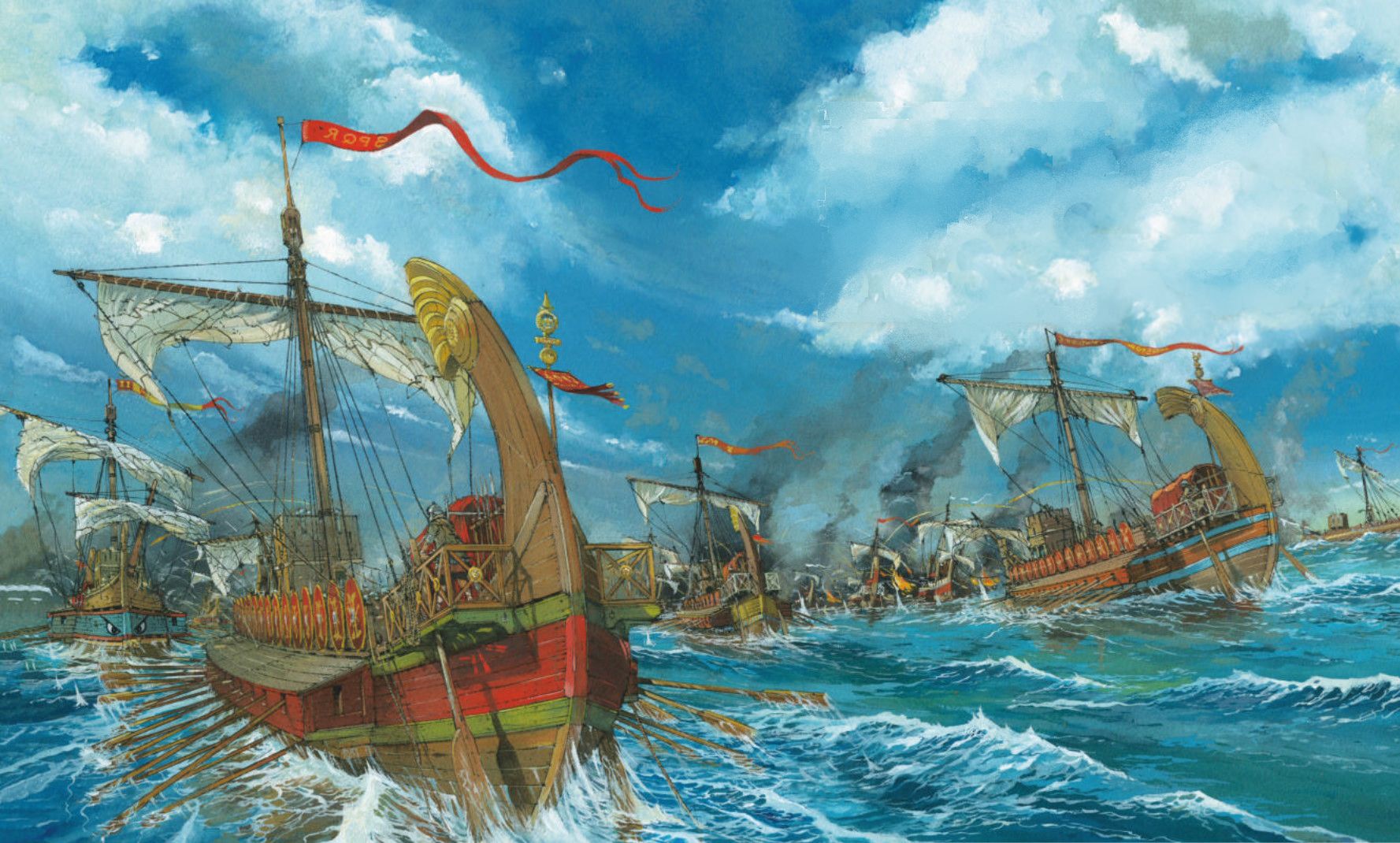
The custom of leaving a commemorative monument or trophy at the site of a victory was a Greek one which spread to Rome. Two striking examples erected by Augustus are illustrated. The first is a 200 foot-long (61 m) podium wall into which were inserted the prows (rostra) of thirty-four warships captured from Antony at the decisive battle of Actium in 31 (the rostra in the forum at Rome were so called because they were similarly decorated). The wall enlarged the precinct of an old temple of Apollo at the southern entrance to the Ambracian Gulf, where Antony had pitched his camp. From uncovering and measuring the wall sockets for the prows, archeologists have been able to deduce the likely size of the ship from which each came; some of the ships were clearly immense.
An engagement was fought on the Ionian Sea on September 2, 31 B.C., just off the coast of this site, near the Ambracian Gulf, between the fleet of Octavian (Augustus) and the armada of Marc Antony and Cleopatra. This naval battle, in which Octavian proved victorious, decided the fate of the Roman world.
By 33 B.C., most political factions striving for power in the Republic had faded, leaving only the Triumvirs Octavian and Antony as rivals. In May 32, they became dire enemies when Antony divorced Octavian’s sister, Octavia (1), and married Cleopatra. Claiming that Cleopatra aspired to become the queen of Rome, and that in his will Antony distributed the Eastern provinces among his illegitimate children by Cleopatra, Octavian roused the Senate and the Roman mob. They called for war against Antony, stripping him of his offices.
Both sides gathered large fleets and assembled legions, but Octavian, with his normal prudence, took his time. Finally, in 31 he set out with hundreds of ships and 40,000 men, landing in Greece and marching south to Mikalitzi, north of Nicopolis on the Bay of Comarus. Antony, possessing a like number of land forces, also had at his command a combined Roman-Egyptian fleet of 480 ships. The advantage rested with Antony in naval terms, because his vessels were large and heavy. Octavian, however, possessed two elements that were to prove pivotal to the outcome: his admiral Agrippa, and his lighter Liburnian ships, which were equipped with the Harpax, a ram that pinned the opposing vessel and allowed for boarding and capture. Antony, encamped just south of Actium, nevertheless stood a good chance of victory.
The battle was really two encounters in a single day, the fierce naval conflict in the morning and a half-hearted rout on land that afternoon. The naval engagement began with the two fleets facing one another. Octavian’s force was divided into three sections – a center and two wings. Agrippa commanded the northern wing and was admiral in chief. Arruntius led the center, and Octavian was in charge of the southern wing. On the Egyptian side, Antony took command of the northern squadrons, opposite Agrippa. Marcus Octavius was opposed to Arruntius, and Savius sailed against Octavian’s ships. Cleopatra headed a reserve squadron of 60 ships behind the center of the Egyptian fleet.
The tactical advantage would fall to the commander who penetrated the other’s flanks, and here the battle was won by Agrippa. Antony fought valiantly, but the unreliable and disloyal ships of his center and south wing broke ranks. Cleopatra sailed to safety, probably signaled by Antony to do so, although the historian Dio Cassius dismissed her flight as the act of a woman and an Egyptian. Antony, with his own ship pinned by a harpax, transferred to another vessel and also fled toward Egypt. Victory at sea was total for Octavian, and Antony’s general, Candidus Crassus, faced a mutiny in his own ranks and surrendered.
An invasion of Egypt followed in July of 30, but Actium had already established Octavian as the undisputed master of Rome and its far-flung world. By August, Antony and Cleopatra were dead by their own hands. Octavian returned to Rome to become the first Roman emperor, Augustus. Plutarch and Dio Cassius wrote extensive versions of the battle.